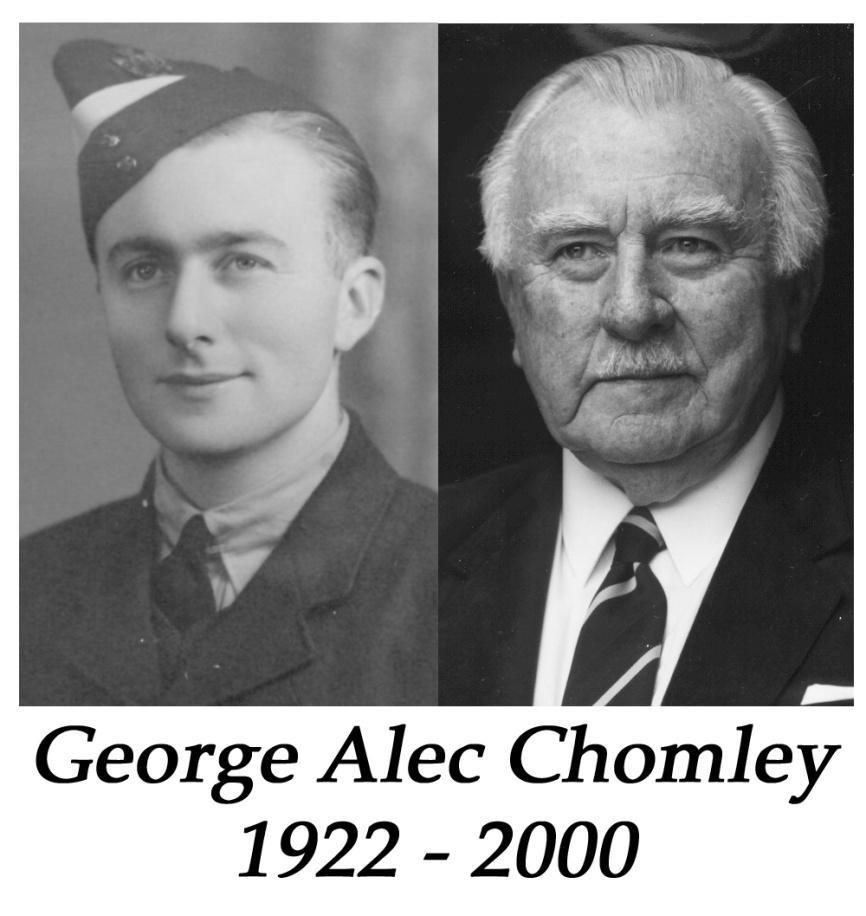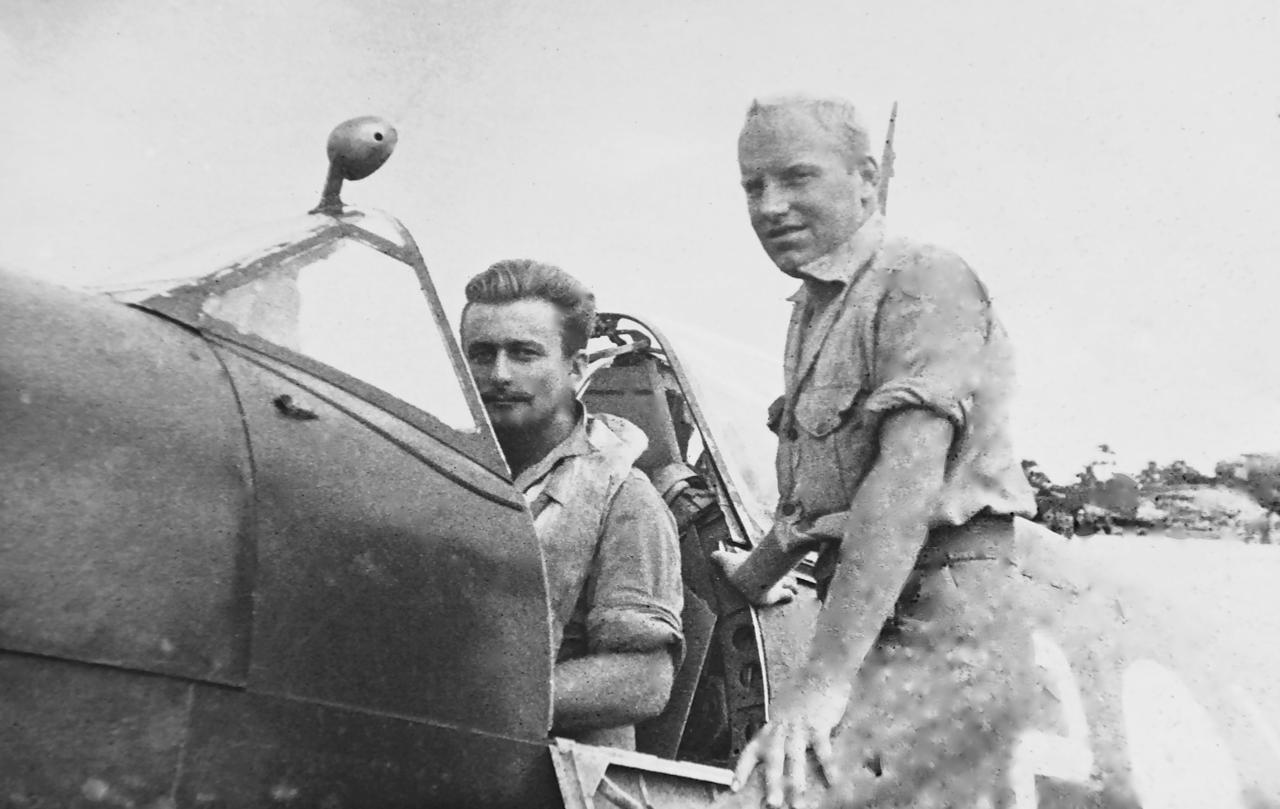PLTOFF George Alec Chomley 418232



| Squadron/s | 79 SQN |
| Rank On Discharge/Death | Pilot Officer (PLTOFF) |
| Mustering / Specialisation | Pilot |
| Contributing Author/s | Langdon Badger and Mike Milln History Group South Australian Aviation Museum Inc July 2013 |
The pilot of the Langdon Badger family's restored Spitfire UP-O², Flight Sergeant G. Alec Chomley, 418232, certainly had an interesting life in the Pacific from the 27 June 1943 until 6 June 1944.
He was trained at 10 EFTS Temora on DH82 Tiger Moths from 12 August 1942 before moving to 5 SFTS Uranquinty for conversion to Wirraways. He then started a more advanced course to attain his wings and rank. Having received his wings and the rank of Flight Sergeant, Alex was posted to 2 OTU Mildura. He again flew Wirraways and the Chief Instructor decided he should convert to Kittyhawks. He says it was here that he stood A29-49 on its nose while landing on 8 April 1943.
On 8 May 1943 he went to Woolamanata, the top secret sheep station, for conversion to Capstans (code name for MK Vc (T) Spitfires). The Australian Army hired the Fairbairn homestead for use as the Southern Command Training School in 1939, and in 1943 the RAAF hired it as a pilots' and officers' mess while No. 79 Squadron RAAF was forming-up under the command of SQNLDR Al Rawlinson DFC and Bar. The Works Training Unit of the RAAF also operated there.
UP-O2 EE853 was a replacement for UP-O1, which experienced a forced landing after its engine failed at 35,000 feet. UP-O2 was flown north by PLTOFF Andy Byrne. Unfortunately he overran the Strip on 18 June 1943 while landing on Gurney's mud soaked pressed steel Marsden matting at Milne Bay, and the aircraft ended up on its nose. A new propeller arrived in a week. The accident also resulted in a slight bend in the fuselage, which is noticeable by the scratches on the left side of the rear canopy plastic and remains to this day.
Alec Chomley was one of the squadron to arrive by ship at Goodenough Island. He first flew a Spitfire, UP-X ES307, on the 27 June 1943 for an aerobatic display in front of the Minister for the Air and Minister for Civil Aviation, Arthur Drakeford. Regrettably the undercarriage would not extend because of a selector failure, even after many bunts to shake it out. Langdon Badger has seen this propeller, bent and highly polished by sliding along the steel matting strip during the belly landing.
Then sharing UP-O² with FSGT George Voges, Alec Chomley drifted on landing at Kiriwina Island on 28 August 1943. One wheel struck the ridge on the side of the coral strip and the aircraft ground-looped. There is a photograph on display at the South Australian Aviation Museum showing the accident, and the painting of the Albert Vargas August Girl from the 1943 Esquire calendar can just be seen above the leading edge of the port wing root. Alec had copied the image from the calendar. UP-O² was broken up for parts and shipped back to Goodenough Island, where Langdon Badger eventually recovered it. Alec, on 12 December 1943, also had a brake failure on landing in UP-R LZ844, causing one wing to remove the cabin of a Blitz Buggy and nearly hit FLGOFF David Hopton who was in it. The aircraft ended up in a coral pit.
During this period Alec had some interesting flights. One was flying cover behind Al Rawlinson up the coast of New Britain. The Intelligence Officer had told them if they ever saw an island ‘moored' off the Coast to attack it because it could be a camouflaged Japanese ship. He said it would look like the island just off the end of the north beach. (See Barry Spicer's painting on the easel behind the Spitfire display at the South Australian Aviation Museum). Al radioed Alec and said "we'd better attack it, but it's a waste of time". This they did and a ship certainly fired back at them. Alec also flew across to Woodlark Island to visit the American Airacobra Squadron. Although he was a Sergeant Pilot he was royally entertained in the Officers' mess for lunch. They thought the Spitfire was a "dear little aeroplane".
Flying from Momote Strip, Los Negros, on 08 May 1944 in UP-V A58-206, Alec had a glycol leak and engine failure 15 miles SW of Los Negros. He rolled V on her back into a shallow dive,"bunting myself out after I inflated the Mae West." In the sea Alec inflated his dinghy and waited about 20 minutes for an American destroyer he had seen on the horizon to come to his rescue. "After I climbed the rope ladder of USS Stockton, the Captain, LCDR Stark made me very welcome with a brandy". This created the opportunity for a dry ship to break a brandy bottle out of the sick bay stock and finish it later in the Ward Room. The bale out and deployment of his dinghy won Alec membership of the Caterpillar and Goldfish Clubs but, according to the Squadron Operations Record Book, he anticipated his Caterpillar Club award by returning to base the following day with a live caterpillar "wriggling from a pin on his shirt.".
Alec was posted on 30 June 1945 to No. 10 Course, CSG at Cressy Victoria. His son, Peter Chomley, tells of a story his mother told him that on 1 July 1945, the day he was born, she was told that Alec was missing while taking a training flight. Alec later walked into the barracks with his trainee having hitched a ride with a farmer from where their aircraft has made an emergency landing.
On 8 August Alec was posted to No. 2 OTU Parkes, where he topped the Instructors' Course CFS to be an instructor on Wirraways. After completing the course, still flying Wirraways, he passed his "rank exams" assessment before being posted to No. 2 OTU Mildura as a Pilot Officer training pilots on Wirraways and then completed 40 Course as a pilot gunnery instructor on Wirraway, Kittyhawk, Spitfire Vc and Mustang aircraft. His last two nostalgic flights were on the 28 August 1944 in Mustang A68-63. His flying hours totalled 881 hours.1 He was discharged from the RAAF on 21 September 1945.
After the War Alec continued his architecture studies at the University of Melbourne under the government training scheme for returned service men and women. On graduation he went into a partnership in his home town of Geelong. He was also on the Board of the Geelong Advertiser, rising to Chairman (9 years) and continuing a family connection that started in 1861, until the paper was taken over by News Limited. His wife Shirley, whom he had married in Adelaide during the War, held a higher rank of Lieutenant as a nutritional advisor to the Army. They were married in uniform and Alec had to salute her at the church altar rail as his senior officer.
They had two children, Peter and Robin. Being great travellers, they went everywhere together in their Camper Van all around Australia. Alec did excellent watercolours of our desert scenery when he saw good subjects. Peter has said that his father had been a shot-put champion and was strong enough to lift him up with one hand when he (Peter) was into his 20s.
In August and September 1980 Langdon and Genevieve flew Alec and Shirley back to Papua New Guinea in Aerostar VH-UYV. They stayed at Port Moresby, Gurney, Kiriwina and Vivigarni, Goodenough Island, which were nearly all the strips Alec had used during his wartime service. At Kiriwina Alec asked to meet visit Billy Warhoo. Billy had been an imp of a nine year old boy in 1943, who used to hang around the pilots. He was particularly attached to Alec and his Spitfire. Billy was very old by then in a country with life expectancy of about 45 years, and their meeting was very moving. He showed Alec a silver two shilling piece Alec had given him and which he still treasured. The whole village turned out for the meeting and watched with rapt attention.
In 1999, Alec and other members of 79 Squadron attended a reunion at Woolamanata. In the ballroom that had been used for briefings, they found diagrams and sketches that had been used during their training days, still stuck on a wall. Langdon Badger, who also attended, was able to purchase a Spitfire ‘mooring case complete' (nowadays called a tie down kit) from John Pettit, the owner. The kit was found behind a locked cupboard door with no key, which required a locksmith to open it.
1 The above notes were taken from Alec Chomley's Log Book